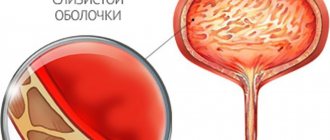Metabolic syndrome (MS) is a complex metabolic disorder based on insulin resistance and compensatory hyperinsulinemia.
This symptom complex is a risk factor for the development of a large number of different diseases.
In the absence of timely detection, lifestyle correction and adequate treatment, metabolic syndrome can lead to the development of such serious ailments in the patient as type 2 diabetes mellitus, atherosclerosis, arterial hypertension and coronary heart disease.
Most often, metabolic syndrome is diagnosed in men aged 30+, but in recent decades the number of recorded cases of pubertal insulin resistance has been growing - that is, similar health problems arise in very young patients.
Most likely, the occurrence of metabolic syndrome in children and adolescents is explained by poor nutrition. This is a truly global problem - according to WHO, today more than 41 million preschool children in the world are overweight.
Symptoms of metabolic syndrome in women often appear after 50 years of age (postmenopausal period); with age, the number of patients only grows.
Early diagnosis of metabolic disorders in combination with the recommendations of an endocrinologist makes it possible to eliminate or reduce the severity of the main manifestations of this syndrome.
Metabolic syndrome: causes
Normally, nutrients entering the body during the process of aerobic (with the participation of oxygen) and anaerobic (without the participation of oxygen) glycolysis should be oxidized to carbon dioxide, water, ammonia, then the body can easily remove these products and begin a new cycle of processing nutrients without harm to organs and systems.
However, an unfavorable environmental situation, unhealthy food, overwork, stress, and hereditary factors lead to incomplete, intermediate oxidation and the formation of small and medium-sized hydrocarbon molecules that accumulate in cells and intercellular substance, deposited on cell membranes and vessel walls.
All this entails disruption of fluid circulation in the body, disruption of the supply of nutrients and oxygen to cells, which ultimately further disrupts metabolism. Also, histamine, serotonin, catecholamines and many other biologically active substances formed in various diseases and injuries that occurred in life accumulate in the body.
It is quite difficult, and in most cases impossible, for the body to cope with so many toxins, which over time leads to the development of various diseases.
A little history
The connection between certain metabolic disorders and cardiovascular disease has been established since the 1940s.
Forty years later, scientists were able to identify the most dangerous factors that lead to cardiovascular diseases and diabetes. They were given a common name - metabolic syndrome. Currently, this syndrome is as widespread among the population of developed countries as the seasonal cold, and is considered one of the most pressing problems of modern medicine. Examinations at Health Centers
Any citizen of the Russian Federation can contact the Health Center if he has a compulsory health insurance policy and a passport. Find out what a Health Center is and find the nearest one in the database on our portal.
Researchers believe that metabolic syndrome will soon
become the leading cause
of cardiovascular disease, overtaking smoking. Today, experts identify several factors related to metabolic syndrome. A person can exhibit any of them, but, as a rule, they occur together.
How does metabolic syndrome manifest?
The presence of MS is indicated by a combination of several clinical symptoms:
- increased blood pressure;
- android type obesity (with predominant fat deposition in the abdominal and upper shoulder girdle);
- disruption of cholesterol metabolism;
- decreased tissue sensitivity to insulin.
A decrease in the sensitivity of cells and tissues of the body to the hormone insulin (insulin resistance) is one of the characteristic signs of metabolic syndrome. In this case, there is often a compensatory increase in this indicator in the blood to maintain blood sugar levels within target values. However, the body's reserve capabilities are individual and not unlimited, and ultimately this can lead to additional disruptions in functioning. As a result, various disorders arise - metabolic, hormonal, cardiovascular, etc.
The pathological process develops slowly, often without pronounced symptoms. Frequent “companions” of excess body weight – high blood pressure, fatigue and shortness of breath – may indicate problems in the body. Visually, this endocrine disorder is signaled by a steadily expanding waistline: in patients with metabolic syndrome, excess fat accumulates mostly in the abdominal organs (which entails further disturbances in lipid and carbohydrate metabolism and complicates the very functioning of the organs).
You can check whether a person is at risk by measuring their waist circumference. With metabolic syndrome in women this parameter exceeds 80 cm, in men – 94 cm.
Other symptoms of metabolic syndrome
You can suspect that a person has metabolic syndrome if the following signs are present:
- increased fatigue, weakness, drowsiness;
- apathy;
- dyspnea;
- complaints of snoring and holding your breath during sleep;
- increased appetite;
- nocturia (nighttime urge to urinate);
- dry or sweaty skin, sometimes hyperkeratosis;
- unquenchable thirst.
Metabolism concept
There are two main definitions of metabolism. According to the first, this is metabolism (metabolism) - a set of numerous chemical reactions occurring in living organisms, thanks to which their growth, vital activity, reproduction, constant contact and exchange with the environment occur.
The second says that metabolism, or metabolism, is the totality of all chemical (enzyme) reactions of metabolism and energy that constantly occur in the cells of living organisms.
Conditionally allocate
:
- resting metabolism, or basic metabolism - the exchange of energy and substances used for the basic functions of the body;
- food digestion metabolism - the energy and substances used to digest food;
- physical activity metabolism - the energy and substances used for physical activity.
The main task of metabolism is to provide the body with energy through the oxidation of nutrients. The second task of metabolism is to use molecules as initial “raw materials” to create the vital components of the cell. The third task is to convert structures that the body does not need (“waste”), mainly into highly water-soluble compounds that can be easily excreted (with urine, feces, sweat, saliva, exhaled air).
In the body, plastic and energy metabolism, which are part of metabolism, are dynamically balanced
:
- plastic metabolism = anabolism = assimilation - biosynthesis of organic substances, components of cells and tissues;
- energy metabolism = catabolism = dissimilation - the breakdown of complex molecules and cell components with the release of energy
The predominance of catabolic processes leads to partial destruction of tissue structures and a decrease in body weight. During catabolism, the chemical energy of compounds released during their breakdown is converted into thermal, mechanical and, partially, electrical energy. The predominance of anabolic processes ensures growth and accumulation of body weight.
Now a little about metabolic rate. This is the amount of energy a person needs to perform basic functions. The rate of transfer of substances and energy from the environment into the body is exactly balanced by the rate of transfer from the body to the environment. Metabolic intensity is assessed by total energy expenditure, and it can vary depending on many conditions, and primarily on physical work. However, even in a state of complete rest, metabolism and energy do not stop, and to ensure the continuous functioning of internal organs, maintaining muscle tone, etc., a certain amount of energy is consumed.
For an adult, the average basal metabolic rate is 1 kcal/kg/hour: for men 1700 kcal/day, for women – 1500 kcal/day.
Factors affecting metabolic rate are as follows
:
- Temperature
: with an increase in body temperature by 1 degree, the value of basal metabolism increases by 13%; An increase in metabolic rate is also observed when the ambient temperature decreases below the comfort zone.
- Age
: After age 40, basal metabolic rate (or metabolic rate) declines steadily, by about 5% every 10 years.
- Exercise stress
: during intense physical activity, energy consumption (catabolism) compared to average energy consumption can increase 10 times, and in very short periods (for example, short-distance swimming) even 100 times.
People with fast metabolisms spend more energy on vital functions such as the heart and brain in the same amount of time than those with slow metabolisms. The reasons for these differences are not entirely clear. Influencing factors (except for static ones: heredity, gender, body type, age) are considered: body weight, psycho-emotional state, diet organization, level of hormone production, physical activity. By controlling these factors, you can influence your metabolic rate to some extent.
Diagnosis of metabolic syndrome
Only an endocrinologist can timely identify this syndrome and differentiate it from other pathologies with similar symptoms (for example, from hypothyroidism, which is often also manifested by weight gain) with the help of professional knowledge, as well as instrumental and laboratory studies (diagnosis of carbohydrate metabolism).
A consultation with an endocrinologist will include a study of the patient’s medical history, collection and analysis of anamnesis, a detailed physical examination with measurement of certain parameters (height, weight, waist and hip circumference, calculation of body mass index, etc.), measurement of blood pressure.
Laboratory diagnosis of metabolic syndrome includes assessment of the state of carbohydrate metabolism, lipid spectrum indicators, if necessary, this is supplemented by a number of hormonal studies.
Instrumental diagnostics of metabolic disorders may include 24-hour ECG monitoring, ABPM, polysomnography and other methods, including ultrasound, CT and MRI.
Also, the attending physician can refer the patient for consultation to other specialists: cardiologist, gynecologist, andrologist, etc.
Increased levels of “bad” cholesterol and decreased levels of “good”
High-density lipoproteins (HDL), or “good” cholesterol, help remove “bad” cholesterol from blood vessels - low-density lipoproteins (LDL), which form atherosclerotic plaques. If there is not enough “good” cholesterol and too much LDL, the risk of developing cardiovascular diseases increases. Attention
! Signs of metabolic syndrome: - HDL level in the blood - below 50 mg/dl, - LDL level in the blood - more than 160 mg/dl, - triglycerides in the blood - 150 mg/dl and above.
Metabolic syndrome. Treatment
Treatment of MS should be competent and comprehensive. Here it is important to take into account and try to normalize all metabolic disorders.
Very often, patients believe that metabolic syndrome requires immediate treatment with drugs. However, the first thing that needs to be done is to remove intermediate metabolic products and excess biologically active substances from the body. This is possible with the help of a course of membrane (filtration) plasmapheresis.
A course of plasmapheresis for metabolic syndrome is prescribed to normalize microcirculation and blood rheology, remove immune and fibrin monomer complexes, medium molecular toxins, and erythropoiesis inhibitors from it; stimulation of fibrinolysis, antithrombin activity; normalization of the permeability of the basement membrane of the glomeruli of the kidneys and, thereby, to restore various metabolic disorders.
Only then can the attending endocrinologist prescribe medications that help normalize metabolic processes and eliminate the symptoms of emerging disorders.
At the MedicCity multidisciplinary clinic, you can undergo diagnosis and treatment of metabolic syndrome and other endocrine diseases at a convenient time from high-class specialists. We will take care of your health!
Tips for Improving Metabolic Flexibility
There are two main ways to improve metabolic flexibility
: First, reduce your total carbohydrate intake in favor of protein and fat, which have already been shown to speed up fat burning in healthy people. Second, increase the intensity of training (aerobic and interval), this speeds up fat burning in both lean and obese people.
For people who are overweight and lead a sedentary lifestyle, exercise is a catalyst for increasing metabolic flexibility even if a change in diet does not produce results in a short period of time.
These studies show that high-intensity interval training can enhance fat burning in both lean and obese people. Combining diet with exercise will help you achieve optimal adaptation to maintain a slim figure and health.
According to one study in obese people, doing aerobic exercise increases fat burning, while restricting carbohydrates and increasing the amount of fat in the diet alone does not achieve this. Scientists believe exercise is a catalyst for improving metabolic flexibility in obese people.
We recommend
“The best courses in nutritionology abroad and in Russia” Read more
Before going to bed, sometimes consume “healthy” fat if you have difficulty falling asleep (tormented by hunger). If your blood sugar is low and your fat burning rate is low during sleep, then consuming a healthy fat like coconut oil may help. This approach helps avoid insulin spikes and deterioration in leptin production. In addition, the body's ability to burn fat at night increases.
Of course, keep clean breaks between meals (no snacking). Limiting your eating to 8-12 hours a day can increase fat burning and lead to weight loss. This method involves abstaining from food outside the “eating window”, which improves fat burning.










